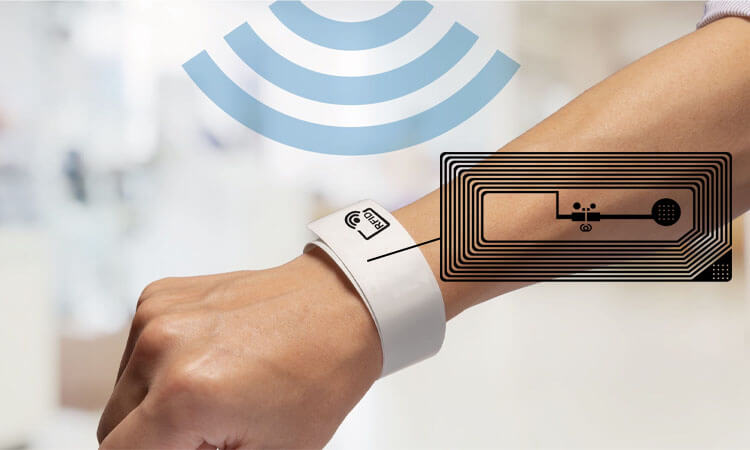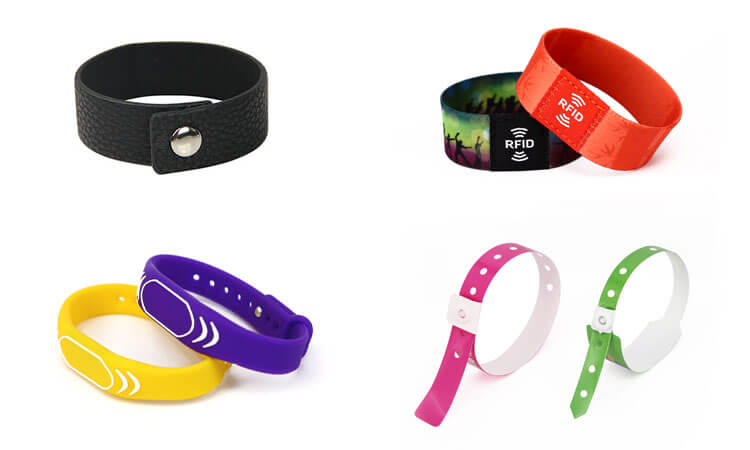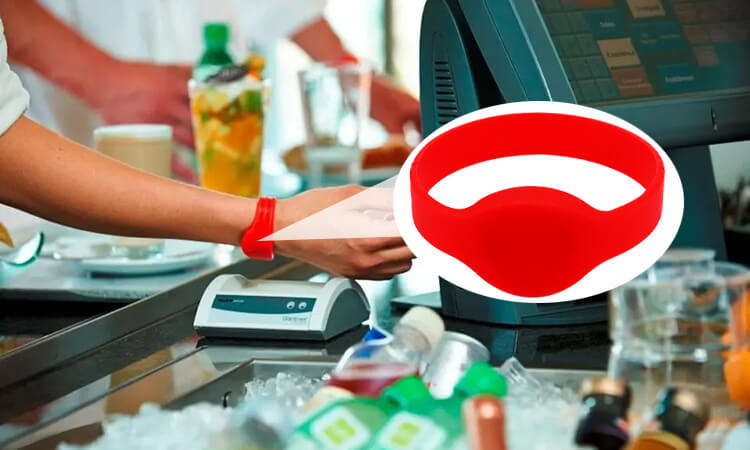If you’re considering investing in RFID wristbands for your business or event, you must choose the right one to ensure you get the most out of your investment. With so many options available, it can be overwhelming to know where to start. In this practical guide, we’ll walk you through the key factors to consider when choosing the right RFID wristband.
What is an RFID Wristband?
RFID wristbands, RFID bracelets, RFID bands, and RFID tags are all terms used interchangeably to describe the same type of technology. These devices are commonly used for access control and authentication purposes in various industries, including healthcare, financial services, and event management.
RFID wristbands, also known as RFID bracelets, serve as a security system that uses radio waves to identify users and their information. These wristbands have an integrated circuit, battery, and radio antenna to store and transmit user data. They are often used in events to control access and prevent unauthorized entry.
RFID bands and RFID tags are also used for access control and authentication purposes. RFID bands are typically worn on the wrist or ankle and use radio waves to transmit data to a receiver. On the other hand, RFID tags are small devices that can be attached to objects or surfaces to track and identify them.
These wristbands are becoming increasingly popular for events due to their convenience and security features. The price of RFID wristbands can vary depending on the type of wristband, with silicone wristbands generally being more expensive than paper or fabric options. RFID bracelets use a scanner or reader to communicate with the RFID chip embedded in the wristband. The RFID system used for the event will determine the type of wristband needed, with options including silicone, chip, fabric, paper, and elastic wristbands.

RFID silicone wristbands are a popular choice due to their durability and customization options. RFID chip wristbands are often used in healthcare and financial services industries to control access and authenticate employees or customers. RFID fabric wristbands are a comfortable and breathable option for events that require extended wear. RFID paper wristbands are a cost-effective option for shorter events, while RFID elastic wristbands offer a secure and adjustable fit.
RFID wristbands comprise an integrated circuit, a battery, and a radio antenna. The integrated circuit stores information about the user, such as their name, date of birth, and medical records. The battery powers the device to transmit this data when needed. The radio antenna sends this information to a receiver, usually located at the entrance of an area where RFID bracelets are required. When people enter this area, they have to place their wrists on a scanner, which transmits their data to the receiver and checks it against the database. If there’s no match (if someone doesn’t have permission to be in that space), alarms will sound, and security personnel will be alerted.
RFID tags are small devices that can be attached to products and animals. They contain a chip and an antenna, allowing them to receive readers’ radio signals. The reader sends out a signal and the tag sends back information about itself, including its unique ID number.
The first RFID tags were developed in the 1940s by Stuart Bergstresser of Sylvania Electronic Systems Central Laboratory in Massachusetts, who used them for inventory control purposes within the company’s manufacturing facility.
The first commercial use of RFID tags was in 1991 when Gillette Company used them to track disposable razor blades. They were first used in the fashion industry in 2005 when Levi Strauss & Co. began using them for inventory management and product authentication.
RFID tags are used in various industries, including retail, manufacturing, healthcare, and security. They can be attached to products or animals and enable real-time tracking of their movements.
Related Articles: Internal structure analysis of RFID tags
Why Buy RFID Bracelets?
You can use RFID bracelets to track all kinds of things, including inventory, attendance, time & attendance, and health data. You can also use them to track entrances and exits, assets, and people/vehicles.
Inventory tracking with RFID chip wristbands. With RFID bracelets you can easily track the inventory you have on hand by attaching an RFID label to a product. As your employees scan each item they receive from their areas, the system will automatically update its inventory database, so you know exactly how much stock is available at any given moment.
Attendance tracking with RFID bracelets. If your company has a policy requiring employees to scan in at the beginning and end of their shifts or when they take breaks during work hours, then this functionality is useful for keeping records of who was where when during those periods (and it’s not just limited to work locations). The same applies if there are any other reasons why it would be beneficial for certain individuals’ movements throughout buildings or facilities to be tracked (elevator usage comes to mind).
Health tracking with RFID bracelets. You can use these devices to track your employees’ health by attaching a medical device or accessory to them, such as an EEG sensor or heart rate monitor (this is just one example). As they go about their day, they will automatically transmit this data in real-time via Bluetooth so that you can keep tabs on their stress levels and energy levels throughout the day.
RFID chip wristbands are a great way to keep track of whatever you want. Whether it’s for work or play, there are many reasons why this technology is useful in the modern world.
RFID Wristband Cashless Payment
RFID wristband cashless payment is a contactless payment technology that uses radio waves to communicate between a wristband and a payment terminal. It is a popular payment method for events, festivals, and amusement parks, as it eliminates the need for physical cash or credit cards, making transactions faster and more convenient.
The wristband contains an RFID chip that stores payment information, and when a payment terminal scans it, the transaction is processed without needing physical contact. This technology is also known as “tap-and-go” payment, and it has gained popularity because of its convenience, speed, and security.
RFID chip wristbands are designed to be durable and water-resistant, making them ideal for use in outdoor events. They can be preloaded with funds, and users can add more money to their wristbands as needed. The system also allows users to monitor their spending and transaction history, making it easier to manage their expenses.
RFID bracelet for cashless payment is becoming increasingly popular in various settings, including concerts, sporting events, and theme parks. It offers a seamless payment experience and eliminates the need for cash or cards, making transactions faster and more convenient for users and merchants.
Related Articles: Cashless Society Pros and Cons
What Types of RFID Wristbands are Available?

RFID bracelets are available in a variety of sizes and shapes. The most common types include:
- RFID Plastic wristbands. These have a woven fabric design, which makes them more sturdy than traditional plastic ID cards. They’re also waterproof and can withstand extreme temperatures (from -40 to 120 degrees Fahrenheit). However, they’re not as strong as metal or leather options and may break if damaged.
- RFID Metal wristbands. Metal options are heavier than plastic ones; therefore, they’re more durable but less comfortable to wear for an extended period of time. They’re also less likely to be damaged by water or extreme temperatures but generally cost more than other types of RFID wristbands because they use higher-quality materials like stainless steel or aluminum alloy that must be cut precisely with lasers in order for them to retain their shape over time — this is why you’ll see prices ranging from $10-$60 per unit (depending on thickness).
- RFID Leather wristbands. Leather is a more traditional option for ID cards, but it’s also one of the most expensive types because it requires more time and effort to create. However, leather can be made into various designs and styles that are both fashionable and durable, making them an ideal choice for companies looking to market themselves through branded merchandise like promotional products or corporate gifts.
- RFID Rubber wristbands. Rubber is a soft, flexible material that can be made into any shape or size; this makes it an excellent option for making custom-printed ID cards or key fobs. It’s also waterproof (with some exceptions) and durable enough to withstand most everyday activities — but it’s not ideal for extreme temperatures because the heat will cause them to become brittle over time.
- RFID Silicone wristbands. Silicone is a soft, flexible material that can be made into any shape or size; this makes it an excellent option for making custom-printed ID cards or key fobs. It’s also waterproof (with some exceptions) and durable enough to withstand most everyday activities — but it’s not ideal for extreme temperatures because the heat will cause them to become brittle over time.
This video details the use of RFID wristbands made of different materials:
RFID wristbands made of silicone in different shapes:
RFID wristbands made of fabric in different shapes:
Factors to Consider when Buying RFID Wristbands
Security
One of the primary benefits of RFID wristbands is enhanced security. Consider the level of security you require for your business or event. Some wristbands offer basic security features, while others have more advanced encryption and authentication capabilities. Determine the level of security you need to ensure the safety of your guests or customers.
Compatibility
Ensure the RFID wristband you choose is compatible with your existing hardware and software systems. This will save you time and money in the long run and ensure seamless integration.
Durability
Consider the environment in which the wristbands will be used. If they are exposed to water, heat, or other harsh conditions, choose a durable wristband that can withstand these elements.
Customization
Do you want to add your company logo or a specific wristband design? Look for options that offer customization to ensure your brand is represented.
Cost
Of course, cost is always a factor to consider. Determine your budget and look for options within that range while meeting your needs.
Choosing the right RFID wristband is crucial to ensuring the success of your business or event. Consider factors such as security, compatibility, durability, customization, and cost when making your decision. You can enhance security, improve efficiency, and provide a better customer experience with the right RFID wristband.
Things to Note When You Buying RFID Wristbands
How Much Does an RFID Wristband Cost?
The cost of RFID wristband depends on the size of the wristband and the number of tags you need. The average cost per tag is $0.25-$1.00, but this can vary depending on which type of tag you choose. For example, a custom logo will be more expensive than a standard one because it takes more time to design and produce the custom artwork for your event.
The price of an RFID chip wristband can also vary depending on the quantity you need. The more tags you order, the cheaper each tag will be. For example, if you only need 1,000 wristbands, they’ll be more expensive than 10,000 because it takes longer to produce them.
Related Articles: The Comprehensive Cost of RFID System Analysis
RFID Wristband Customization Options
You can customize an RFID wristband in a variety of ways:
- Color: many companies offer the option to choose from various colors, including reds and blues.
- Message/text on the wristband: you can write anything that you want on your own custom-made RFID wristband! This includes names or dates (such as “Happy Birthday Mom”) and even logos or brand names that represent who you are as a person (e.g., if you’re a big Harry Potter fan).
- The material used to make the band: Several different materials are available for making your customized RFID chip wristband. They include:
- Silicone rubber (which is waterproof),
- Plastic polyester (more durable than silicone rubber but less resistant to water),
- Leather (durable; great for stylish designs),
- Cloth fabrics like cotton or silk (good for those who don’t want something too flashy),
- Paper substrates such as cardboard (these often come with adhesive backing so that they stick better onto clothing without needing holes punched into them beforehand).
- The size and shape of the band: you can choose from various shapes for your wristband, including round, oval, rectangular, square, etc. The size will vary depending on your design type (for example, if you want to make a bracelet that wraps around someone’s arm).
How do You Make an RFID Wristband Waterproof?
If you make your RFID bracelets or buy them online, you may face a waterproofing dilemma.
The first step is to determine how waterproof you need the wristband to be. A simple coating should suffice if it’s just for in-store use and won’t touch water often. One way we recommend doing this is by using an adhesive label or sticker on top of your custom design. This will give it enough protection from moisture that it won’t affect its functionality and ability to transmit information via radio waves.
If your wristband is used more frequently in wet environments, then consider applying a sealant instead of just a label or sticker overtop (you’ll want something like Liquid Mask 2X). This goes beyond basic waterproofing and seals out moisture under the surface of where you place them onto materials like plastic—which makes them perfect for when people do things like swimming! Because they’re made specifically as sealants rather than just labels/stickers that can come loose over time due to normal wear-and-tear factors such as friction during everyday activities (like rubbing against other surfaces). There’s much less chance that these materials will come loose during normal use. So they last longer without breaking down after being exposed repeatedly over long periods with regular washings/cleanings.”
Related Articles: Are Waterproof RFID Tags Really Waterproof?
Will a Gift Card Work with an NFC-enabled Device If It has a Sticker on the Back of It?
If you have an RFID gift card and want to use it with your phone, you may have considered removing the sticker on the back. The thought process is that without the sticker, your phone can read the tag on your gift card.
While this is true, it doesn’t mean that removing the sticker will make your gift card work with an NFC-enabled device. The reason is simple: The sticker acts as a shield to prevent interference from other sources that could cause errors when reading information from a tag. Removing this shield could cause errors in reading information from a tag because there isn’t enough space between tags close to each other (such as those found within wallets).
The best way to ensure your gift card works with an NFC-enabled device is to leave the sticker on. If you do need to remove the sticker from your gift card, there are some things you should know:
- Don’t remove the sticker with metal scissors. This could damage the card and cause errors when reading information from a tag.
- Make sure you don’t leave any residue behind on your gift card after removing the sticker.
- If you want to remove the sticker from your gift card, try using nail polish remover or rubbing alcohol. Be sure to wash and dry your hands before touching any part of the gift card again.
- If you’ve removed the sticker from your gift card, it’s important to know that some of the information on the card will no longer be protected. This means that it could be more susceptible to being stolen by thieves who have NFC-enabled devices and want your personal information.
How are RFID Bracelets Used for Security and Fraud Prevention?
RFID bracelets are used for several applications. They can verify a person’s identity, track inventory and attendance at events, track people in crowded places (such as concerts), and even help hospital staff keep track of patients. The way that RFID wristbands work differs from application to application. Still, the basic premise is the same: instead of using an ID card or badge to identify yourself as an employee, event attendee, or patient, you wear your identification on your wrist.
The most common use for RFID bracelets is employee identification at large companies like Amazon and Walmart — which means that when you walk into their stores, you don’t need to stop at the front desk first by swiping your credit card or showing them your driver’s license before telling them what department you’re looking for—or having someone scan their own ID badge before they let anyone inside.
This process eliminates any need for employees to carry badges with them all day because everything has been digitally recorded onto one small piece of plastic attached around their wrists!
There are many other uses for RFID chip wristbands as well: One common place where businesses use them is at sports stadiums. They often ask if you would like an RFID ticket printed out or emailed when you buy tickets online. This means there is no need to worry about forgetting your tickets when you arrive at the stadium because everything is connected.
The same goes for concerts or other events where you have to show a ticket to get inside. Instead of having a physical ticket that could get lost or stolen, RFID bracelets can be used as an alternative. This is especially helpful if you’re attending an event by yourself and don’t want people entering areas that are not permitted for them (for example, children at a concert).
How Many Times can an RFID Wristband be Used?
RFID wristbands can be reused as many times as you want. The number of uses depends on the RFID tag inside the wristband, though. Some tags have a cycle of 1,000 to 10,000 uses while others may only last 100 or so cycles.
For example, if you’re using an RFID tag designed for 1 million cycles and your guests keep leaving their wristbands at home when they leave your event. Then it would make sense for you to change their band with one with a lower cycle count instead of purchasing a brand new band every time someone forgets theirs!
Can an RFID Wristband be Read from a Distance?
RFID bracelets can be read from a distance, but it depends on the type of tag and reader you’re using. Most RFID tags are passive, meaning they don’t have an internal power source like batteries. Instead, they use radio waves from the reader device to power them up and transmit data about themselves that’s encoded in an electromagnetic field.
The range at which these tags can be read varies depending on factors, including the size of the item tagged (larger items have more surface area for transmitting signals). And whether you’re using low-frequency or high-frequency (HF) radio waves to communicate with them (HF has a higher capacity). The quickest way to find out what kind of wristband your venue uses is to ask someone who works there—they’ll know!
If Wristbands are for One-time Use, How Long will They Last?
RFID wristbands are designed for one-time use, but this does not mean they will only last for a year or two. Some types of RFID wristbands can last for years and decades, depending on the quality of the wristband and how you take care of it. Some could even last for centuries or millennia!
If you want an RFID chip wristband that will last for millions or billions of years, simply follow these tips:
- Don’t wear it in water.
- Do not get caught wearing your RFID bracelet while swimming (this includes going underwater).
- Keep your wristband away from heat sources like fireplaces, ovens, and microwaves (Note: This may cause permanent damage to both your property as well as yourself).
- Keep your wristband away from sharp objects like knives and scissors (This will prevent damage to your bracelet and yourself). Do not wear your wristband in places with high levels of radiation (this could cause permanent damage to both your property as well as yourself).










